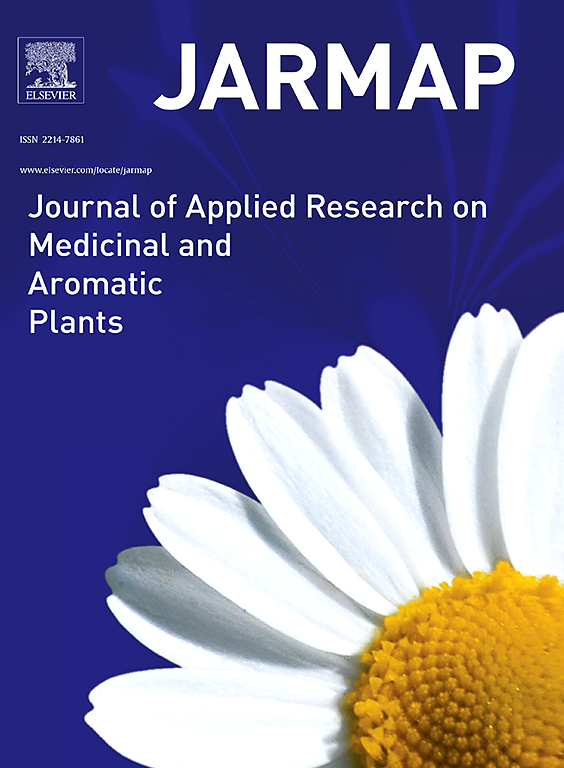Diosgenin production from Dioscorea zingiberensis tubers by novel pressurized hydrolysis in acidic ionic liquids
IF 3.6
2区 农林科学
Q1 PLANT SCIENCES
Journal of Applied Research on Medicinal and Aromatic Plants
Pub Date : 2024-10-24
DOI:10.1016/j.jarmap.2024.100596
引用次数: 0
Abstract
Diosgenin (25R-spirost-en-3β-ol; CAS No.: 512–04–9), a plant-derived natural product, has significant importance for manufacturing steroid-based drugs. It is primarily prepared by direct acid hydrolysis, but this out-of-date process is not environmentally friendly. In recent decades, ionic liquids have shown good potential to replace conventional organic solvents in many fields. The aim of this study was to develop a novel approach for diosgenin production, in which the acidic ionic liquid [BHSO3MIm]HSO4 was employed under pressurised conditions to hydrolyse the crude saponin of Dioscorea zingiberensis C. H. Wright tubers for the first time. The hydrolysis conditions were optimised through a one-factor-at-a-time experiment, and the maximum yield of diosgenin was achieved at 3.71 ± 0.18 % with an ionic liquid concentration of 0.5 M, a solid–liquid ratio of 1:30 g/mL, a hydrolysis temperature of 140°C, and a hydrolysis duration of 0.5 h. The diosgenin yield was 75.67 % of the maximum yield after six consecutive applications of [BHSO3MIm]HSO4. The yield achieved was comparable to pressurised acid hydrolysis and microwave-assisted ionic liquid hydrolysis and significantly higher than that of direct acid hydrolysis (P<0.01). Meanwhile, catalyst consumption was 0.123 mol/g diosgenin, which was much lower than that of microwave-assisted ionic liquid hydrolysis (0.600 mol/g). Moreover, the hydrolysis reaction was completed within 0.5 h, which was only one-third of the conventional pressurized acid hydrolysis. This newly established method has significant merit in hydrolysis duration and is associated with decreased catalyst consumption, and [BHSO3MIm]HSO4 is of good reusability, making it a greener and more economical method for diosgenin preparation.
通过在酸性离子液体中进行新型加压水解从薯蓣块茎中生产薯蓣皂苷
薯蓣皂苷(25R-螺甾-烯-3β-醇;化学文摘社编号:512-04-9)是一种源自植物的天然产物,对生产甾体类药物具有重要意义。它主要通过直接酸水解法制备,但这种过时的工艺并不环保。近几十年来,离子液体在许多领域显示出取代传统有机溶剂的巨大潜力。本研究旨在开发一种生产薯蓣皂苷的新方法,首次在加压条件下使用酸性离子液体 [BHSO3MIm]HSO4 来水解 Dioscorea zingiberensis C. H. Wright 块茎的粗皂苷。在离子液体浓度为 0.5 M、固液比为 1:30 g/mL、水解温度为 140°C、水解时间为 0.5 小时的条件下,薯蓣皂苷的最高产率为 3.71 ± 0.18 %。连续使用六次[BHSO3MIm]HSO4 后,薯蓣皂苷产率为最高产率的 75.67%。该产率与加压酸水解和微波辅助离子液体水解相当,明显高于直接酸水解(P<0.01)。同时,催化剂消耗量为 0.123 摩尔/克二氢雌酚,远低于微波辅助离子液体水解的催化剂消耗量(0.600 摩尔/克)。此外,水解反应在 0.5 小时内完成,仅为传统加压酸水解的三分之一。这一新建立的方法在水解持续时间方面具有显著优势,同时减少了催化剂的消耗,而且[BHSO3MIm]HSO4具有良好的重复使用性,是一种更环保、更经济的二猕猴桃苷制备方法。
本文章由计算机程序翻译,如有差异,请以英文原文为准。
求助全文
约1分钟内获得全文
求助全文
来源期刊

Journal of Applied Research on Medicinal and Aromatic Plants
Pharmacology, Toxicology and Pharmaceutics-Drug Discovery
CiteScore
6.40
自引率
7.70%
发文量
80
审稿时长
41 days
期刊介绍:
JARMAP is a peer reviewed and multidisciplinary communication platform, covering all aspects of the raw material supply chain of medicinal and aromatic plants. JARMAP aims to improve production of tailor made commodities by addressing the various requirements of manufacturers of herbal medicines, herbal teas, seasoning herbs, food and feed supplements and cosmetics. JARMAP covers research on genetic resources, breeding, wild-collection, domestication, propagation, cultivation, phytopathology and plant protection, mechanization, conservation, processing, quality assurance, analytics and economics. JARMAP publishes reviews, original research articles and short communications related to research.
 求助内容:
求助内容: 应助结果提醒方式:
应助结果提醒方式:


